Overview
ResuMe is a resume managing application made specifically for University students by University Students to allow then to add and manage their different experiences, edit personal data, and create the resume of their dreams in just a few commands.
Summary of contributions
Code contributed:
Link to my code [Code]
Contribution to team based tasks:
Morphed Commands in overall architecture
-
What it means: Commands that are item dependent are now separated to their own separate class according to the item type that they modify, to be created by parser and calls on changes in the model.
-
Justification: This is to make sure that the logic of each excution of each command class is independent from the type that it is linked to. Eg. ListCommand is split into ListResumeCommand and ListSkillCommand… ListXYZCommand will show all XYZ without having to check what Item type is passed into it.
Set up the foundation for tests
Created typical classes, item builders, assert command success and failure to aid the team in the setting up of tests.
Manage releases
managed releases for release v1.3 and v1.4.
Enhancements implemented:
Preview a resume: rpreview
-
What it does: Allows users to preview their fleshed out resume in the application before generating it.
-
Justification: This was done to provide users with a ability to go check their resumes for any typos or make sure that all their relevant experiences have been added to the resume before actually making it into a PDF file. This will save users' time as generating the PDF does take some time, and decrease the clutter as users would not have to generate many files.
-
Highlights: This feature wrote the framework to to pass data back to UI and allow the creation of the window with the text data. This feature made enhancing the
helpcommand much easier due to similar logic and styling.
List all items: list
-
What it does: Allows users to view all items of a certain type.
-
Justification: This is done so that users know what items they have to pick and choose from to add into their resume.
-
Highlights: Bigger rework on UI and CommandResult so that CommandResult passes up the type currently showing for UI to update and give visual feedback to users.
Clear all data: clear
-
What it does: Allows users clear all their data to start fresh.
-
Highlights: This feature was morphed from AddressBook so that it can work with our data types, undo, and redo.
Wrote tests for add, clear, done, list, rpreview, view, JsonAdaptedInternship, EditUserCommand…
-
Played an integral role in pulling coverage up from 23% to 83%.
Contributions to the User Guide
Given below are sections I contributed to the User Guide. They showcase my ability to write documentation targeting end-users. |
{Start of extract 1: Introduction}
Introduction
Hello fellow University friends! Have you ever found writing resumes for job and internship applications a hassle? Have you ever dreamt about an app that can help you manage different resumes for different companies? Have you ever wished for a more streamlined Command Line Interface application that can match your efficiency and typing prowess?
If this sounds like you, ResuMe is the resume managing application for you! Made by University students for University students with looovee, this wonder understands your struggle and strives to cater to your specific resume needs and job application woes.
{End of extract 1: Introduction}
{Start of extract 2: List Command}
Listing all items : list
Lists items in the storage.
Format: list i/ TYPE
|
|
|
Examples:
-
list i/ res: Lists allresumeitems.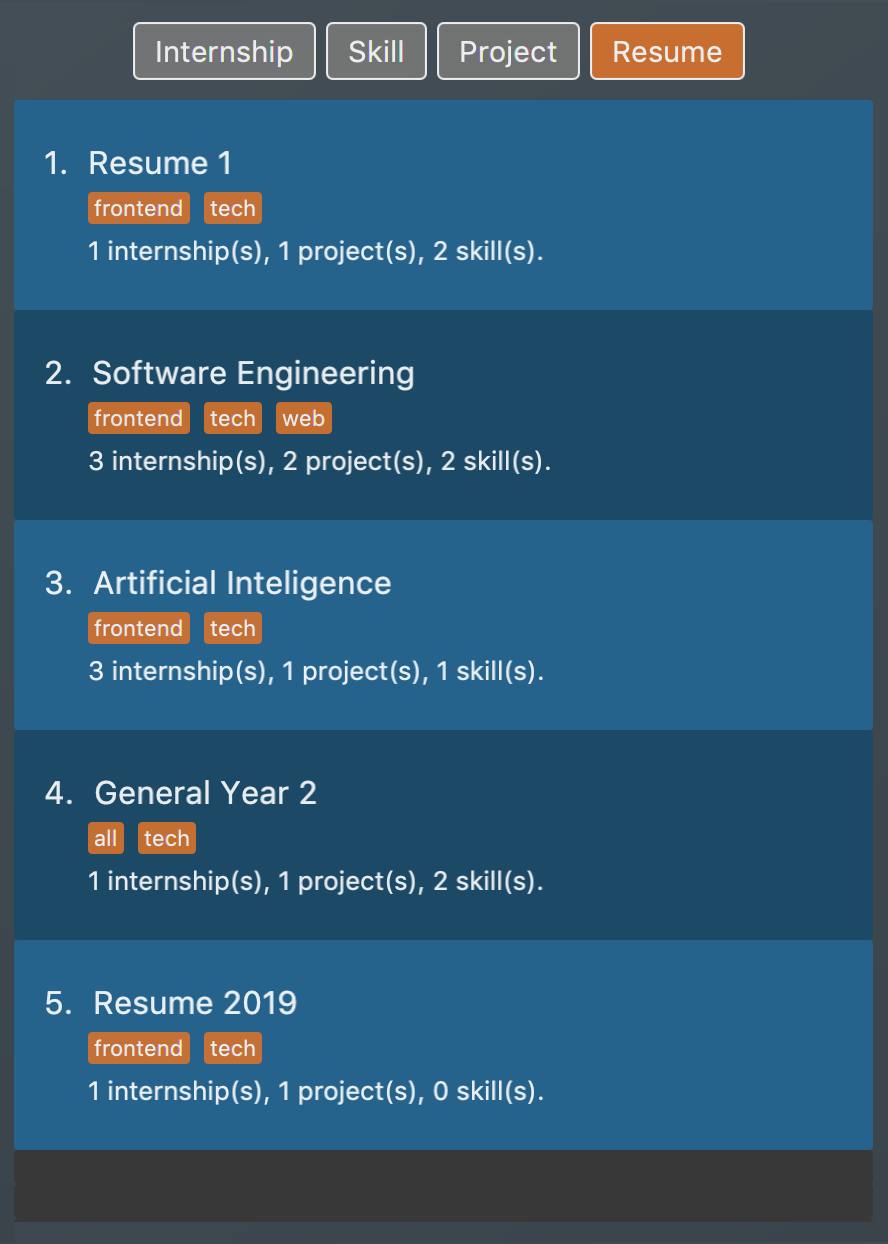 Figure 1. List of all resume items
Figure 1. List of all resume items -
list i/ int: Lists allinternshipitems.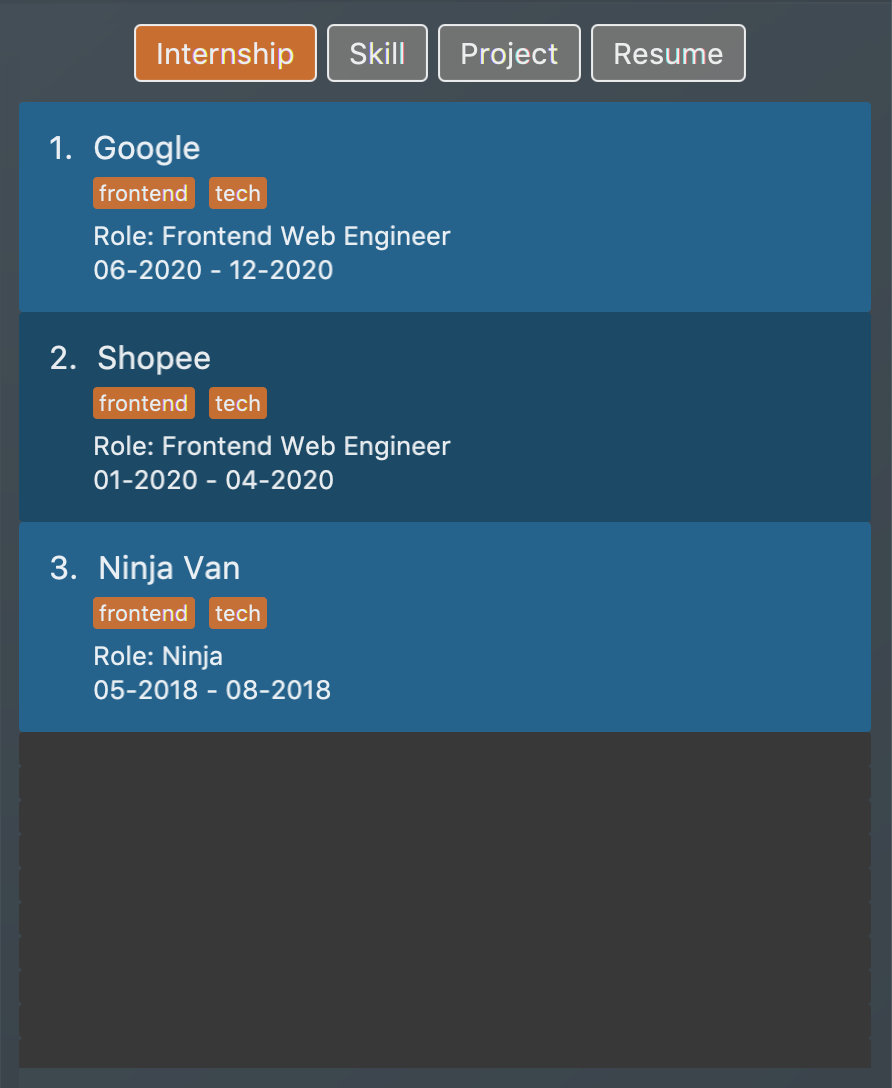 Figure 2. List of all internship items
Figure 2. List of all internship items -
list i/ note: Lists allnoteitems.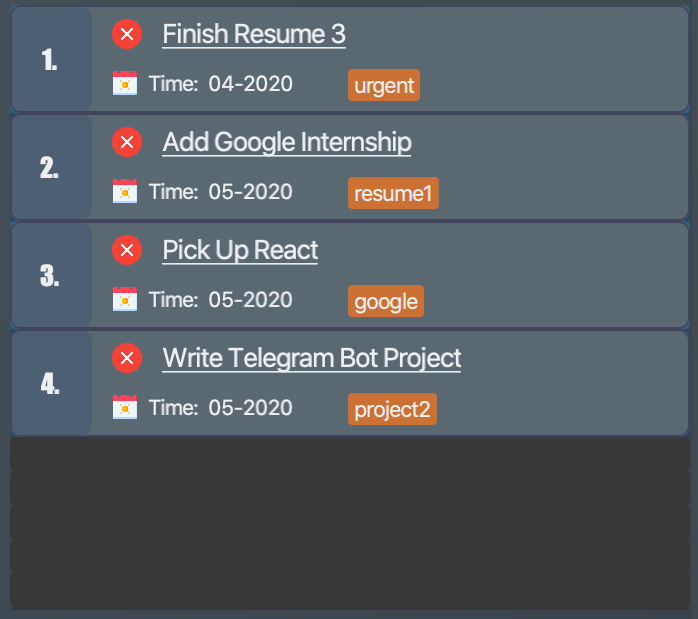 Figure 3. List of all note items
Figure 3. List of all note items
{End of extract 2: List Command}
{Start of extract 3: Resume Preview Command}
Previewing a resume: rpreview
Previews a resume in text format in a pop-up window.
Format: rpreview RESUME_INDEX
|
|
Example: Let’s try out the following commands!
-
list i/ res -
rpreview 2
Outcome:
-
The first command lists out all
resumeitems. Assuming that you want to preview the secondresumein the list box.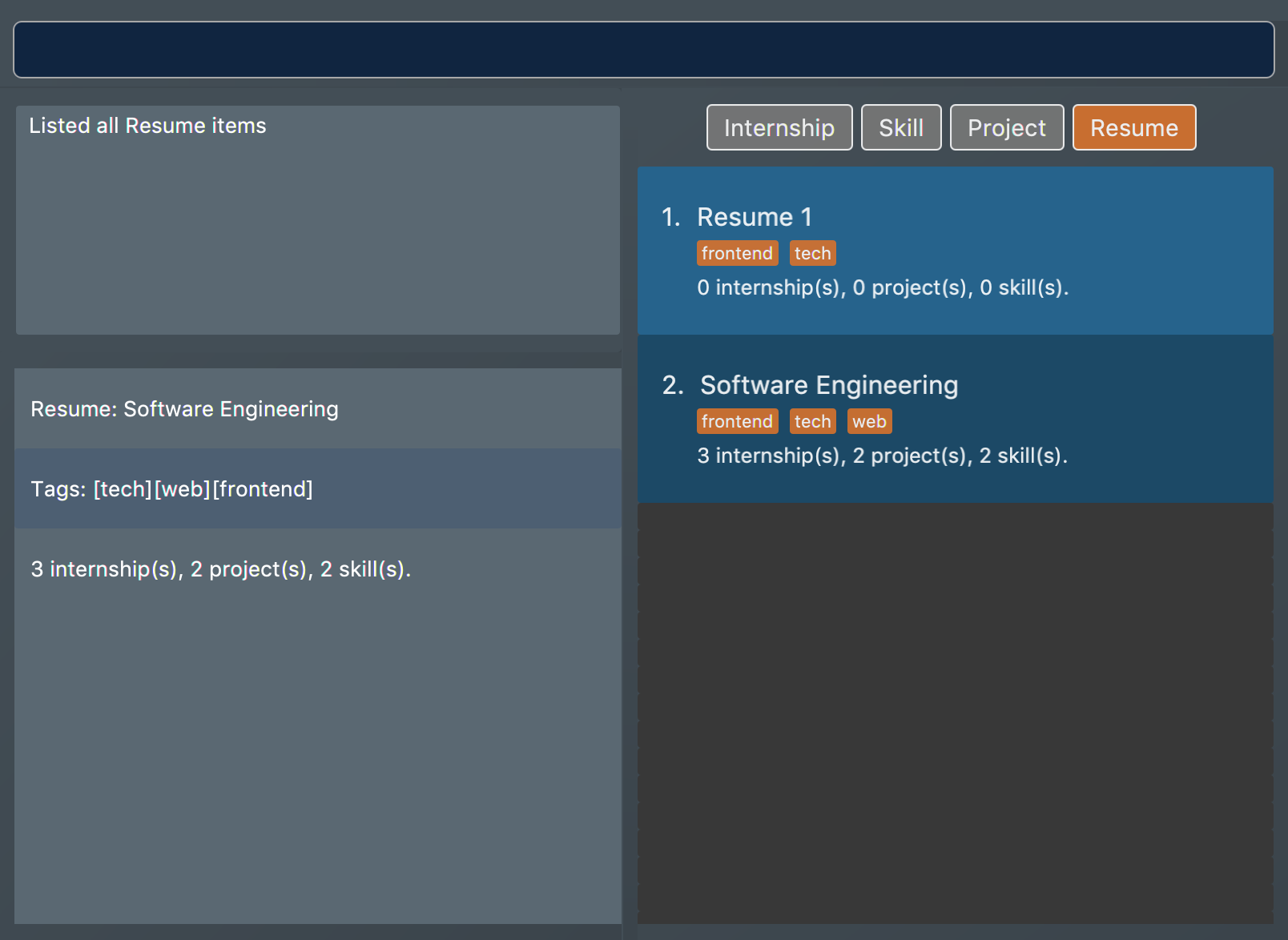 Figure 4. List of all resume items
Figure 4. List of all resume items -
The second command will preview the
resumeat index 2 named "Software Engineering". A pop-up window will be opened, featuring a text-based view of the content of "Software Engineering". The screenshots of the results are as shown below: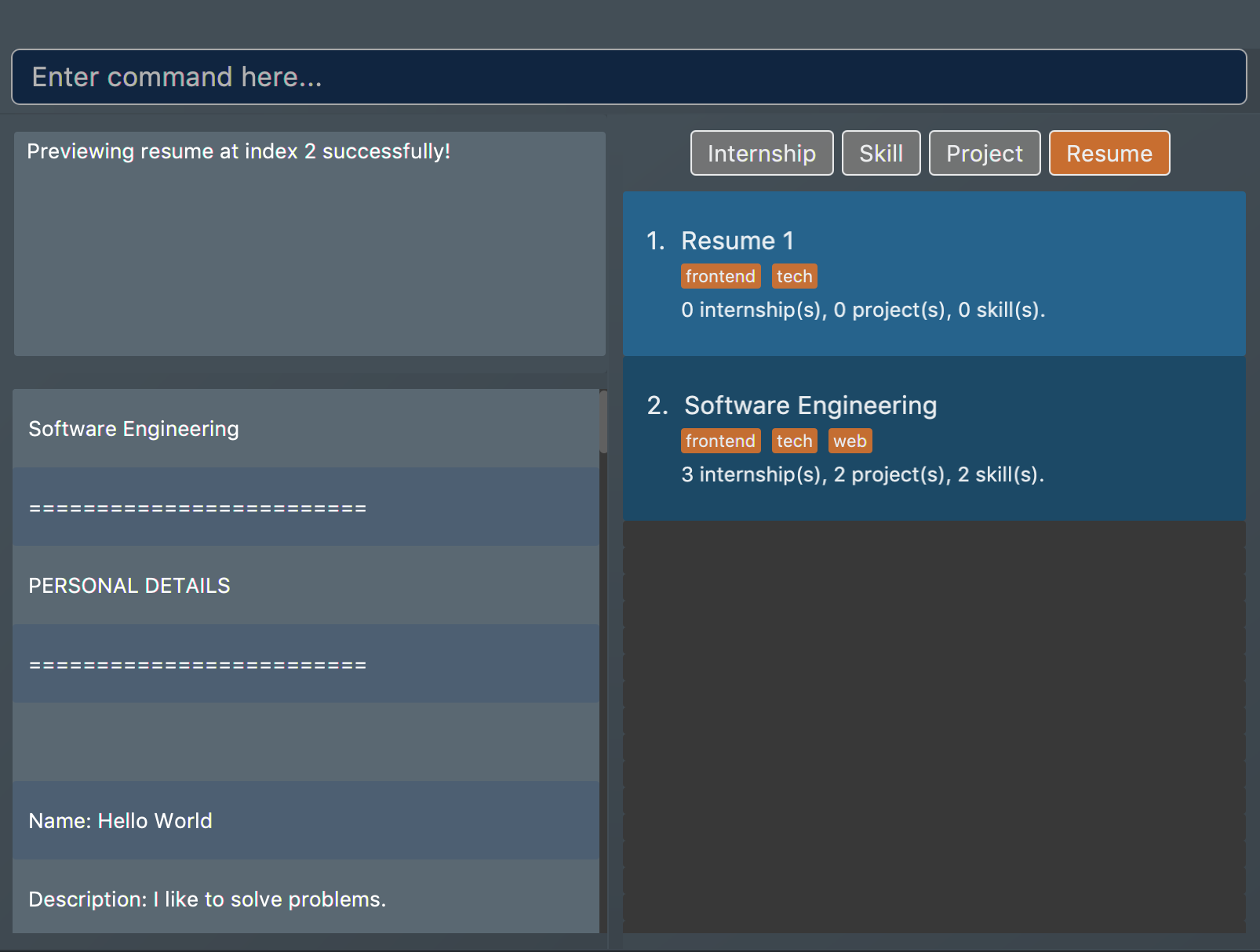 Figure 5. Application view after rpreview is executed
Figure 5. Application view after rpreview is executed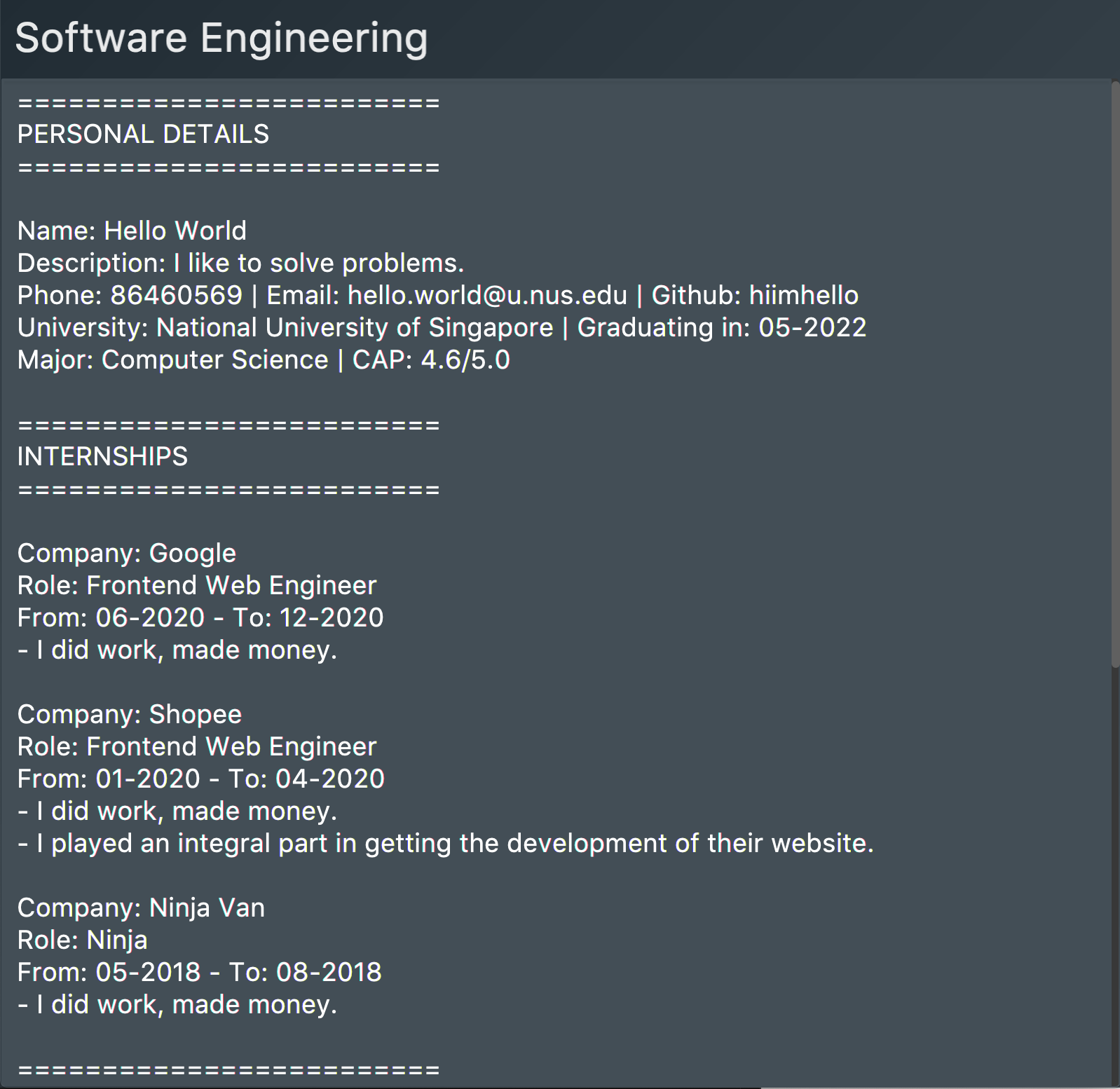 Figure 6. Preview pop-up window
Figure 6. Preview pop-up window
{End of extract 3: Resume Preview Command}
{Start of extract 4: Clear Command}
Clearing all data: clear
Clears all data from ResuMe. Empties all data in the resume book, user information is replaced with default user information.
Format: clear
| This command can be undone. |
{Start of extract 4: Clear Command}
{Start of extract 5: Command Summary}
Command Summary
This is a summary of all available commands for your reference.
General commands
These are commands that have consistent format regardless of item type.
| Command | Format |
|---|---|
Clear |
|
Delete |
|
Done |
|
Exit |
|
Find |
|
Help |
|
List |
|
Me |
|
Redo |
|
Sort |
|
Undo |
|
View |
|
Item-specific commands
These are commands whose format varies depending on item type.
| Command | Type | Format |
|---|---|---|
Add |
Internship |
|
Project |
|
|
Skill |
|
|
Resume |
|
|
Note |
|
|
Edit |
Internship |
|
Project |
|
|
Skill |
|
|
Resume |
|
|
Note |
|
Resume commands
These are commands specific to resume items.
| Command | Format |
|---|---|
Edit Resume |
|
Generate Resume |
|
Preview Resume |
|
Tag Pull |
|
{End of extract 5: Command Summary}
Contributions to the Developer Guide
Given below are sections I contributed to the Developer Guide. They showcase my ability to write technical documentation and the technical depth of my contributions to the project. |
{Start of extract 1: Overall Architecture}
How the architecture components interact with each other
The Sequence Diagram below shows how the components interact with each other for the scenario where the user issues the command delete 1 i/ ski, delete skill at index 1.

delete 1 i/ ski commandThe figure above explains quite clearly how the input of the user is passed into the system through Ui that calls
Logic to make changes in the Model and saves to Storage. However, it may not be immediately clear how the Ui is
then updated to give visual feedback to the User. The updating of the Ui is actually done through a combination
of observable items, lists, and updating of the Ui with data passed through commandResult.
Head to [UI component] to read more.
How the architecture components interact at start up
The Sequence Diagram below shows how the components interact with each other at start up.
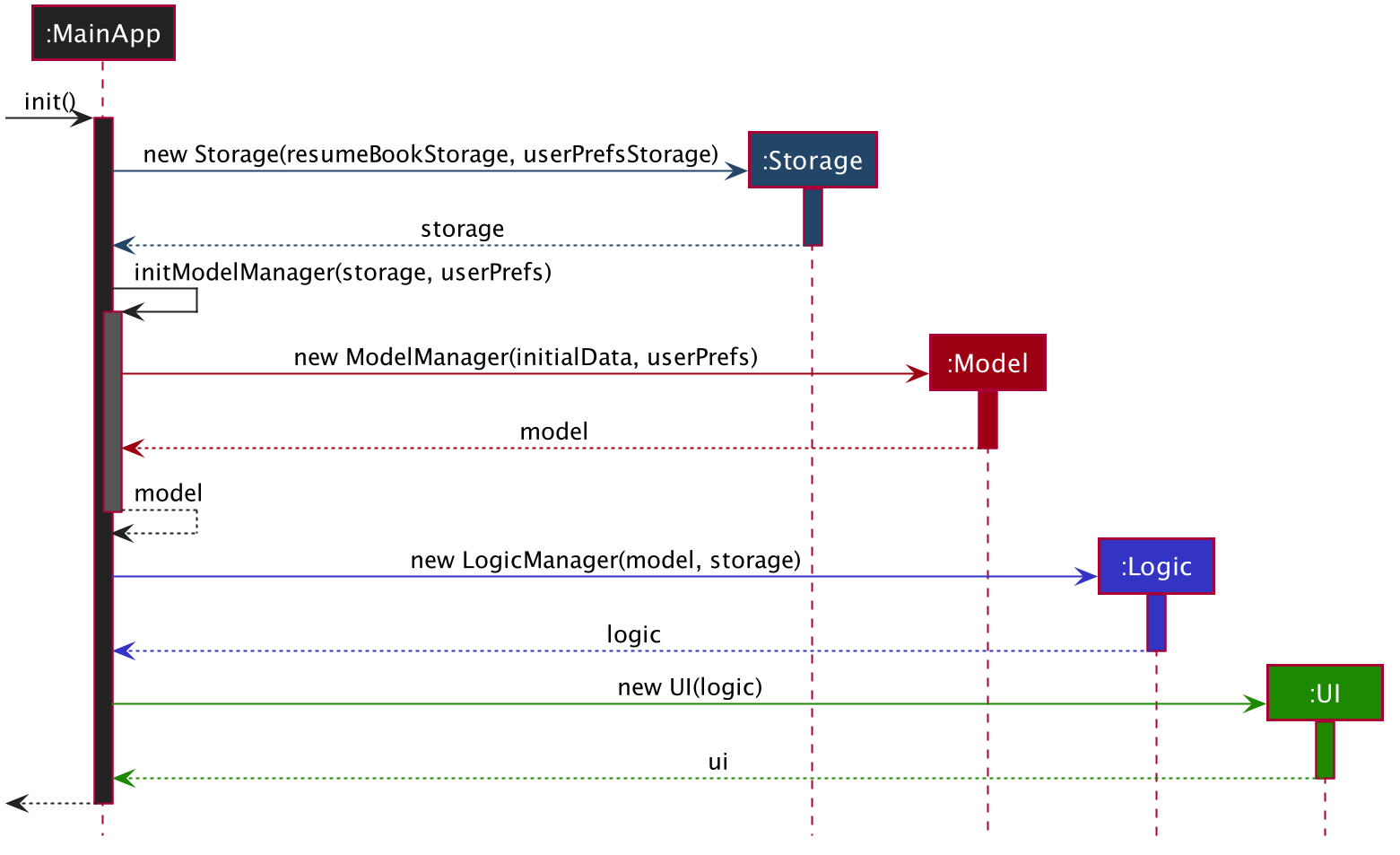
The sections below give more details of each component.
{End of extract 1: Overall Architecture}
{Start of extract 2: Implementation of Command Classes}
Implementation of Command classes
Current Implementation
Currently, there are several object Type which are subclasses of Item, namely Resume, Internship, Skill, Note
and Project.
Commands that are dependent on item Type, namely AddCommand, DeleteCommand, EditCommand, FindCommand,
ListCommand, SortCommand, and ViewCommand are implemented as abstract classes that inherits from Command and would have a
concrete classes that corresponds to each item Type. For example, AddCommand is an abstract class that
AddInternshipCommand and AddSkillCommand inherits from.
Commands that are not dependent on item Type (eg. EditUserCommand, ResumeEditCommand) are implemented as concrete
classes that inherits directly from Command.
From this point onwards, for the sake of clarity in our discussion, commands that are dependent on type will be called ABCCommand whereas those who are independent of type will be called XYZCommand.
The following is the class diagram for Command and its subclasses.
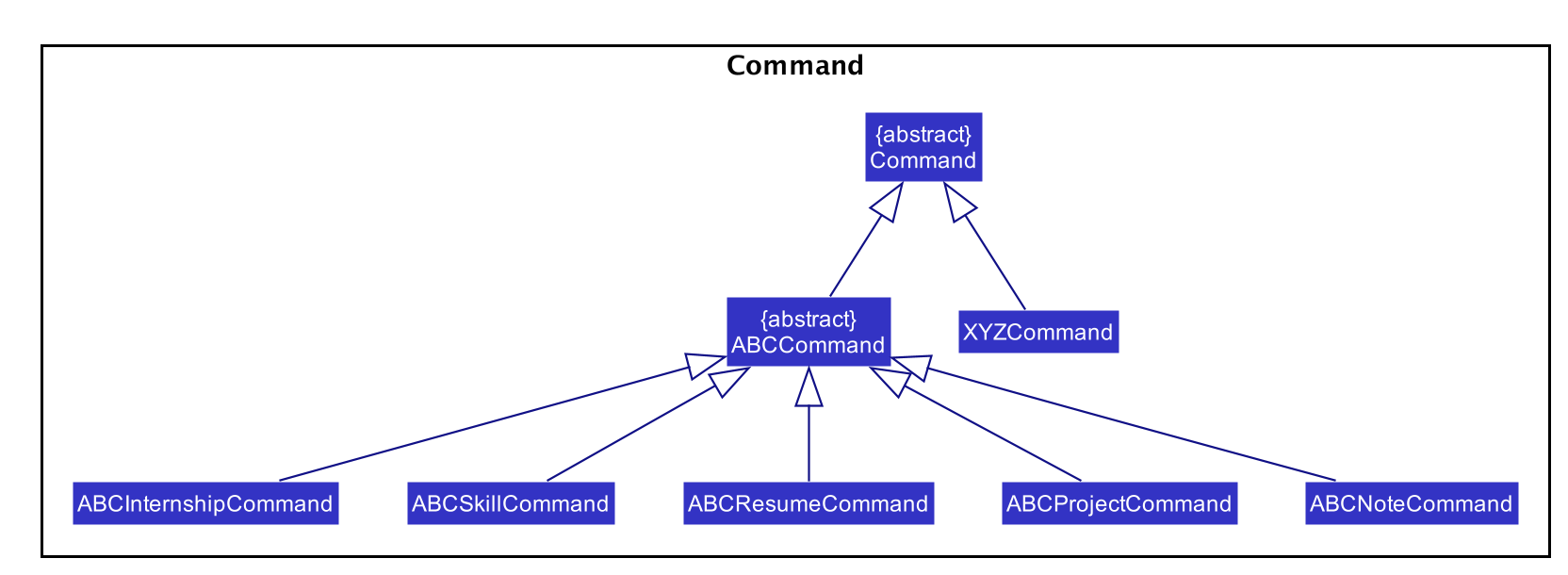
XYZCommand is independent of Type whereas ABCCommand is dependent on Type.Design Considerations
Aspect: Whether to separate the ABCCommand that is dependent on type into many ABCItemCommand
Alternative 1 (current choice): ABCCommand is separated into many ABCItemCommand. Parser will parse user input and create the exact ABCItemCommand.
The following is the activity diagram for execution of AddResumeCommand when the user adds a resume.

AddResumeCommandThis leads to a cleaner execution method of each ABCItemCommand as each command class has a clear goal.
-
Pros: More OOP. Each
ABCItemCommandhas its own and distinct functionality. EachABCItemCommandhas more flexible behaviour and can be easily changed as required. -
Cons: Many classes have to be maintained.
Alternative 2: ABCCommand is not separated into many ABCItemCommand.
The following is the activity diagram for execution of AddCommand if AddCommand is not separated into AddResumeCommand,
AddNoteCommand, AddInternshipCommand, AddProjectCommand, and AddSkillCommand when the user adds a resume.

AddCommandImplementing ABCCommand this way forces execute to be switch-cased.
Functionality of execute would vary depending on the item Type.
-
Pros: Only one command is required, regardless of number of items. Low overhead.
-
Cons: Long
executemethod due to the need for handling the different item types as seen from the logic of the activity diagram. ItemTypewould also need to be stored. Undesirable variable functionality ofexecutecommand depending on theTypefield despite it being from the same class. ie.AddItemcan addInternshipto theInternshiplist, or addSkilltoSkilllist.
{End of extract 2: Implementation of Command Classes}
More contributions (not rendered for brevity):
-
User Stories
-
Manual Testing